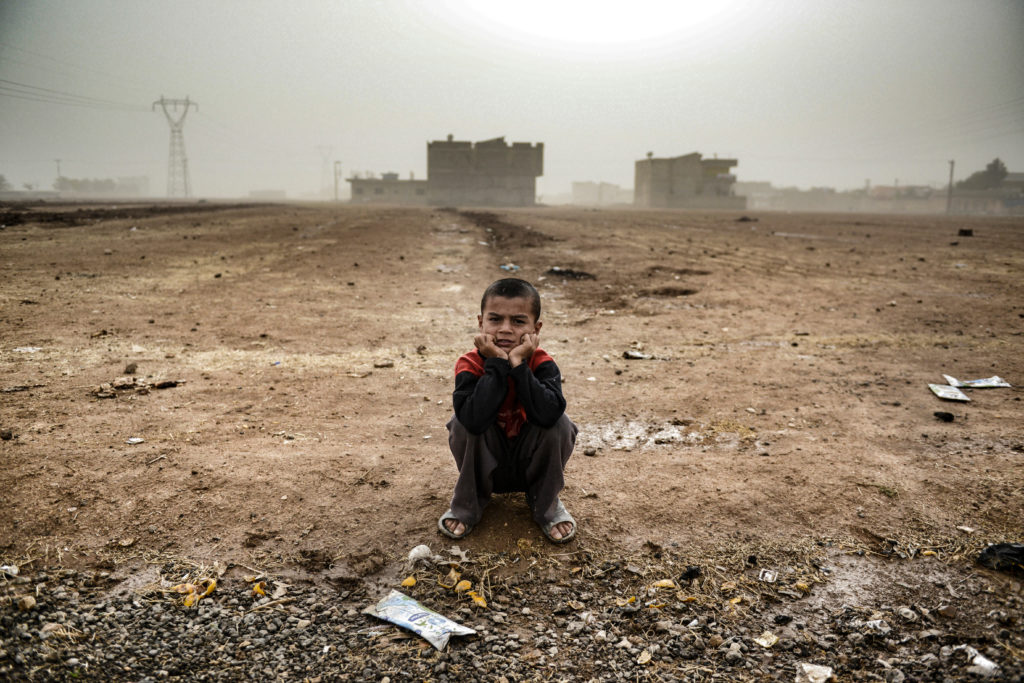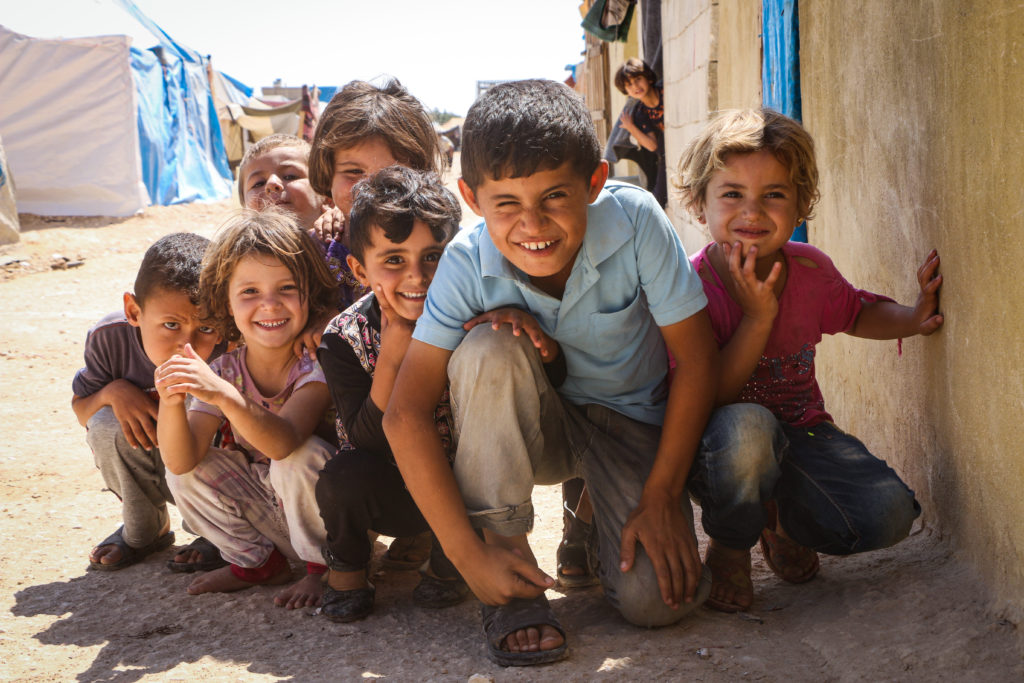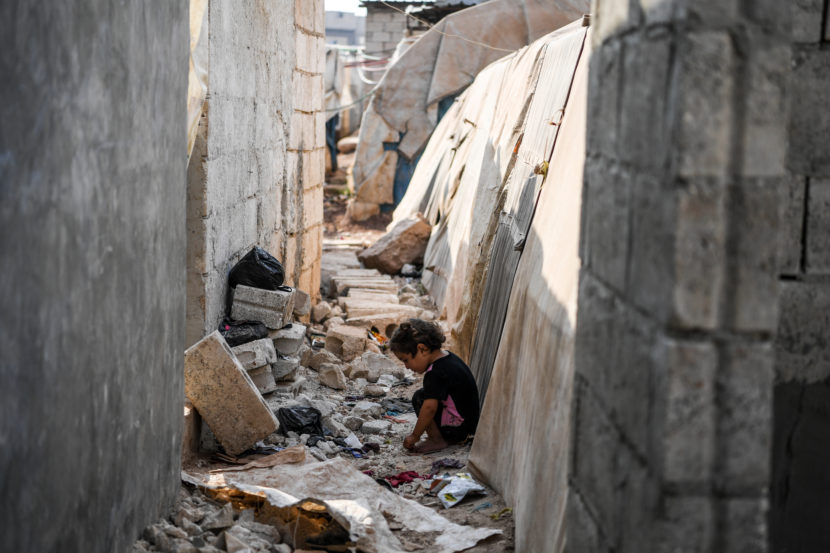The Syrian conflict has left a devastating legacy of unexploded ordnance (UXO) and landmines, posing a persistent threat to the lives of children. In the first months of 2025, the situation worsened, with over 100 children killed by these remnants of war in a single month alone.
Historical and political background
Syria’s civil war began in 2011 with popular protests against the long-standing Assad regime and quickly escalated into a brutal, multi-faceted conflict. Over the years, fighting among government forces, various rebel groups, and extremist factions—with heavy involvement from international actors—has led to hundreds of thousands of deaths and massive displacement. The war has left the country deeply fragmented and impoverished (CFR, 2024).
Exacerbating the already dire circumstances, after withdrawing from cities such as Raqqa, ISIS left behind a deadly legacy by planting mines throughout the city. The group strategically laid these explosives in nearly every area—including streets, public spaces, and residential neighborhoods—with the goal of instilling fear, disrupting enemy advances, and hindering the safe return of residents, including children (Hanoush, 2018).
Over the past decades, international law has established strict rules on the use of landmines. Key treaties, including the 1980 Convention on Certain Conventional Weapons and its 1996 amendments, require that mines be used only against legitimate military targets (ICRC, n.d.). Similar treaties include the 1997 Convention on the Prohibition of Anti-Personnel Mines (Ottawa Treaty) and the 2008 Convention on Cluster Munitions (ICRC, n.d.).
The CCM Convention requires parties to a conflict to distinguish at all times between civilians and combatants, to direct operations only against military objectives and to take constant care to spare civilians and civilian objects. On the basis of this Convention, cluster munitions such as exploding and expanding bullets, anti-personnel mines and more are considered as weapons prohibited under International Humanitarian Law (ICRC, n.d.).
However, it’s important to note that Syria is not a party to any of the referenced Conventions (UN, n.d.). As a result, Syria is not legally bound by its provisions, which may explain the widespread use of landmines and unexploded ordnance (UXO) in the country. Nevertheless, Syria is a party to the Convention on the Prohibition of Chemical Weapons (CWC), but its involvement with various international treaties has been a complex and contentious issue (OPCW, n.d.).
The scale of the crisis
Since 2011, landmines have killed 3,471 civilians in Syria, including 919 children, and injured at least 10,400 others, with many requiring amputations and long-term medical care. The use of landmines escalated after the 2011 uprising, particularly along the borders with Lebanon and Türkiye, and remains a serious threat, especially for internally displaced persons, relief workers, and civilians (Syrian Network for Human Rights, 2024).
Save the Children reported that seven children were killed in Syria within two days due to landmine and unexploded ordnance (UXO) explosions. Four children died in Idlib after a UXO detonated in an abandoned apartment, while three others were killed in Homs when a landmine exploded on farmland. In 2022, 22 people, including seven children, were killed, and 29 others, including three children, injured in similar incidents (Save the Children, n.d.).
Since the war began, Syria has become the most heavily contaminated country with landmines, unexploded ordnance (UXO), and explosive remnants of war (ERW). The International Campaign to Ban Landmines and the International Cluster Munition Coalition (ICBL-CMC) reported that Syria recorded the highest global casualties from landmines in 2020, with 2,729 victims, half of whom were children (The White Helmets, n.d.).
The deadly legacy of UXO
Syria’s landscape is littered with more than 300,000 landmines and UXO, endangering the lives of approximately five million children living in contaminated areas. The conflict has resulted in over 422,000 reported incidents involving UXO across 14 governorates, with half of these incidents ending in tragic child casualties. The alarming rate of child casualties due to UXO has been consistent over the years, making it the primary cause of child deaths in Syria (UN, 2025).
A systematic review analyzing pediatric war casualties in the Syrian Civil War found that children account for up to 25% of civilian casualties and are more likely to sustain blast injuries from landmines and unexploded ordnance (UXO) than adults. The study, which examined 14,833 pediatric war casualties across 39 studies, revealed that blast injuries were the primary cause of life-threatening injuries (Jhala et al., 2024).
Despite advancements in conflict medicine, pediatric casualties have higher mortality rates than adults, largely due to their smaller body size and limited training for trauma surgeons. The Syrian conflict, characterized by aerial bombings and urban warfare, has further exacerbated risks for children, with many hospitals and healthcare facilities destroyed, leaving military and humanitarian hospitals to bear the burden of care (Jhala et al., 2024).
The lasting psychological impact of war on children

The Action on Armed Violence report on the impact of explosive violence on children’s psychological health highlights the devastating long-term mental and emotional effects of such violence. Children exposed to explosive violence, whether directly or indirectly, often experience grief, anger, self-blame, depression, and anxiety, with many effects persisting into adulthood. Studies show that exposure to explosive violence leads to PTSD in 23%– 70% of people in conflict zones like Syria and Palestine, with children among the most vulnerable (Hubbard, 2021).
The long-term consequences of explosive violence include toxic stress, disrupted cognitive and emotional development, and societal stigmatization. These children often struggle in school, have difficulty forming relationships, and may face exclusion due to disabilities. The absence of proper psychological support in conflict zones exacerbates these issues, as countries like Iraq, Yemen, Libya, and Syria lack pediatric psychiatrists (Hubbard, 2021).
One tragic example of these psychological effects is seen in the story of Abeer, a young Syrian widow, who was interviewed by Syrian-American writer Lina Sergie Attar in 2020. Living in a refugee camp in Lebanon, Abeer recounted how her husband was killed in a 2015 bombing claimed by ISIS, leaving her to care for their six children alone. The trauma of this event deeply affected her eldest daughter, who once had beautiful handwriting but, after witnessing her father’s death, lost her ability to speak properly (ReliefWeb, 2021).
Call for action
Since 2016, the Syrian Civil Defense (White Helmets) has been leading efforts to remove UXO. Their teams conduct disposal missions, and community awareness campaigns to educate civilians about the dangers of unexploded ordnance. From 2021 to 2022, the White Helmets conducted hundreds of operations, and destroyed 859 munitions, including over 21,000 cluster bombs. Despite these efforts, four volunteers have died during clearance operations, highlighting the extreme risks involved (The White Helmets, n.d.).
Humanitarian organizations are calling for urgent international support to fund demining efforts, mine-risk education, and assistance for survivors. The cost of demining, estimated to be tens of millions of dollars, is seen as a small price to pay compared to the lives that could be saved. Immediate investment in clearing explosives is crucial for ensuring the safety of communities and supporting Syria’s recovery.
While children demonstrate resilience in the face of explosive violence, without proper support, trauma can disrupt their development, leading to persistent anxiety, and social isolation. Given the lack of pediatric mental health resources in many conflict-affected regions, targeted interventions—such as trauma-informed care, community-based support systems, and education programs—are crucial in helping children rebuild their lives (Hubbard, 2021).

We stand for the protection of children everywhere. We believe in a world where every child can grow up in safety, with access to education, healthcare, and the opportunity to thrive. Your support—whether through volunteering, donations, or becoming a member can help continue life-saving initiatives and create lasting change for vulnerable children around the world.
Written by Lidija Misic
Bibliography:
CFR (2024), Syria’s Civil War: The Descent Into Horror. Retrieved from CFR at https://www.cfr.org/article/syrias-civil-war, accessed on February 25, 2025.
ICRC (n.d.), 2008 Convention on Cluster Munitions. Retrieved from ICRC at https://www.icrc.org/en/document/2008-convention-cluster-munitions, accessed on March 3, 2025.
ICRC (n.d.), Practice relating to Règle 81.Restrictions on the Use of Landmines. Retrieved from ICRC at https://ihl-databases.icrc.org/fr/customary-ihl/v2/rule81, accessed on February 25, 2024.
Hanoush Feras (2018), The Legacy of ISIS-Manufactured Mines in Raqqa. Retrieved from Atlantic Council at https://www.atlanticcouncil.org/blogs/syriasource/the-legacy-of-isis-manufactured-mines-in-raqqa/#:~:text=Throughout%20the%20conflicts%20in%20Syria,the%20group’s%20defeat%20in%20Raqqa., accessed on February 25, 2025.
Hubbard Verity (2021), The impact of explosive violence on children’s psychological health. Retrieved from AOAV at https://aoav.org.uk/2021/the-impact-of-explosive-violence-on-childrens-psychological-health/, accessed on February 24, 2025.
Jhala Tobias et al (2024), Injury pattern of pediatric war casualties in the Syrian civil war: a systematic review. Retrieved from The Journal of High Threat and Austere Medicine at https://journals.cambridgemedia.com.au/jhtam/volume-6-number-2/injury-pattern-pediatric-war-casualties-syrian-civil-war-systematic-review, accessed on February 24, 2025.
Organisation for the Prohibition of Chemical Weapons (n.d.), Syria and the OPCW. Retrieved from OPCW at https://www.opcw.org/media-centre/featured-topics/opcw-and-syria, accessed on February 28, 2025.
ReliefWeb (2021), The impact of explosive violence on children’s psychological health. Retrieved from ReliefWeb at https://reliefweb.int/report/world/impact-explosive-violence-children-s-psychological-health, accessed on February 24, 2025.
Save the Children (2022), Syria—Seven Children Killed by Landmines in Two Days, Says Save the Children. Retrieved from Save the Children at https://www.savethechildren.org/us/about-us/media-and-news/2022-press-releases/syria-seven-children-killed-by-landmines-in-two-days, accessed on February 24, 2025.
Syrian Network for Human Rights (2024), On the International Day for Mine Awareness and Assistance in Mine Action, We Are Still Discovering New Areas Contaminated With Landmines in Syria, With More Deaths and Injuries Recorded Across the Country. Retrieved from ReliefWeb at https://reliefweb.int/report/syrian-arab-republic/international-day-mine-awareness-and-assistance-mine-action-we-are-still-discovering-new-areas-contaminated-landmines-syria-more-deaths-and-injuries-recorded-across-country-enar, accessed on February 24, 2025.
The White Helmets (n.d.), Landmines and Unexploded Ordnance… A Deadly Legacy for the Syrians. Retrieved from The White Helmets at https://whitehelmets.org/en/latest/media-releases/landmines-and-unexploded-ordnance-a-deadly-legacy-for-the-syrians, accessed on February 24, 2025.
United Nations (n.d.), High Contracting Parties and Signatories CCW. Retrieved from UN at https://disarmament.unoda.org/the-convention-on-certain-conventional-weapons/high-contracting-parties-and-signatories-ccw/, accessed on February 28, 2025.
United Nations (2025), Syria emergency: Four children a day killed or injured by leftover explosives. Retrieved from UN at https://news.un.org/en/story/2025/01/1158971#google_vignette, accessed on February 24, 2025.


